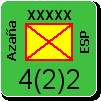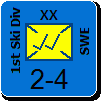ORIGINAL: Orm
ORIGINAL: Joseignacio
Composer, I tried to explain myself the best that I could without the chart in my hands. And i posted it this morning because some mornings I have small breaks at work, which are not so usual after it, so I had to take advantage although I didn't have the chart at that moment.
Of course, it is not into MWIF, since MWIF is using a certain version of RAW but after it there is the FiF that came with the Annual. However, I understand this is a thread on the rules of WIF, not only MWIF.
Anyway, the 3d10 charts that come with the Annual, plus all the rest of the explanation were only there to explain the context (that under the FiF 3d10 table -option 2- the naval bombarment could be made up to the total of attacking factors unmodified by terrain- but modified by supply, offensive chits, ...) but the question itself is the same under RAW, FiF or whatever: Is a fort "terrain" or is it something else that modifies the factors? Like supply does, amphibious assault, city, factories ...
Because I was told a fort is "terrain" and I don't think so.
In the 3d10 charts notes it says (my bolding):
"Attacking modifiers provided by individual units are affected by
terrain (rivers,
forts, invasion, etc.) in the same manner as their combat factors (ex. halved across rivers)."
To me that shows that forts are considered terrain.
For sure it does. I hadn-t read that part, if I had, the question would never had been posted. Thanks! This was in the other sheet and I hadn't noticed.
If you play with the 3d10 option 2 (Advanced shore bombardment and ground support) the maximum support you can use are the total combat factors unmodified by terrain. But on the other hand the maximum support in a non city hex is half and in a city it is quarter of the attacking/defending strength. (Invading units are calculated differently)
So if I read the rules correctly the attacking support is not modified (halved) by the fort (terrain) but since the rule says the maximum support should be halved in Gibraltar (since it is a non city hex) the result is the same. The only difference is the defenders support and for invading units but then again an invading unit would not have attacked across the fort hexside anyway.
Well, to explain this I should tell how this game options were selected. Every time we had a game the most experienced player in our group used to surprise us using some obscure optional rule that had not been selected or unselected especifically.
Because of this, now we try to select all the options carefully before the games. It took me 2 weeks (that weeks I was unusually busy, that's why) to find a list of the possible options, check anyway all the RaW references to options, ..., and decide.
Finally, there was a list of accepted options. In this list like 90% of the options where we disagreed I had finally got what I wanted; in exchange, he just wanted that we played with FiF.
I had previously played with FiF, but I always have a mess about which rules come with which expansion of the game, so I assumed FiF was about the factories' builds mainly. I prefer the old system but new one is not so bad, so I said "yes".
I had previously played with the 3d10 table and the rules that 50% of those that you lose in your own territory (in supply) while defending come back as production points, and although I like the fact that 3dices' results are more central than 2 dices, I don't like the results of the table, they are enforcing attacks too much (the Outcome). Of course, this is compensating a rule that I hate, the 50% "undead soldiers" rule which i mentioned before.
When I was told, at the beginning of the game, that FiF included all of these, which I thought were part of the Annual (didn't know Annual -that year- was FiF), we had to renegotiate again, because FiF is not an optional itself but a module which has several optionals included.
I did not accept the limits of 1/2 and 1/4 to bombardment in non-city and city, and we played like this, but then the attack to Gibraltar came, and I has previously fortified it as much as possible, because we play with the option that allows to align Spain and it's becaming pretty fashionable to invade Gibraltar inmediately from Africa (strait)m from Spain, with shore bombardment and with some stukas and some heavy artillery attacking from hexes that have no land connection.
I fortifed with good units, which were white, so that in case that they were flipped kept a value of 3 instead of 1 if they were unsupplied, built a fort and tried to have always ships supplying.
All was for nothing because the german player used half his luftwaffe, many elite troops, ..., his navy (mine was at port because it was the beginning of the turn), ..., and they took Gibraltar easily which made war in the mediterranean a nightmare for me, specially because he obviously had collapsed Vichy and he was moving his soldiers all along Northern Africa taking minors, unnoposed, while I had to fight back for each mile, with the disadvantage of having to bring every soldier and plane by ship from England or (later) the USA.
This may not have happened if he couldn't have added do much support from planes and ships because of my fort, because the "1/2 - 1/4 naval bombardment" optional rule was not accepted, so wether it was terrain or not had a decisive influence.
BTW, the German embarked in a ships and planes war in the Cape San Vincent, and some dilatory tactics in Northern Africa, which meant he had to make a lot of combined impulses even in good climate, which meant that he did not advance in the USSR front. Barely Kiev and Minsk (we are in summer 43), which has allowed the Russian to have a huge army in front. Now the advances are tiny in either side, I am afraid even if I (British) surrender the Italian and disembark in France, it´s almost impossible to win the german through automatic victory in time. The russian front has became a Sigfried/Maginot and he can easily make another Siegfried in France or Germany.









